IHCantabria moves towards a deeper understanding and more effective management of estuarine ecosystems, with the DIES project
This project brings together research and technology to address pressing environmental challenges. Among its most significant results are the creation of a BioLibrary and maps of estuarine biodiversity using information provided by optical sensors such as those housed in Earth observation satellites.
“Advancing the understanding of Biological Diversity and Ecosystem Functioning through Spectral Analysis” (DIES, for its acronym in Spanish) is the title of a project that is revolutionizing the way biodiversity in coastal estuaries is understood and studied. These places are vital ecosystems, because they harbor a unique and essential biodiversity for the functioning of the marine ecosystem, and because they provide ecosystem services of great value to society, especially for coastal societies.
The DIES project is part of the Marine Sciences Programme (PCM) of the Institute of Environmental Hydraulics of the University of Cantabria(IHCantabria). Its execution is programmed until 2025, with the support of Barbara Ondiviela and Cristina Galvan, as principal investigators (PI) of this project, who are part of the Coastal Ecosystems Group of IHCantabria.
Traditionally, the characterization and monitoring of biodiversity in estuaries has been based on classical approaches that quantified the number of species -taxonomic biodiversity-, and the functions they perform in the ecosystem -functional diversity-. However, these methods have limitations in its applicability to the spatial and temporal scales necessary for estuarine management and conservation. And this is where remote sensing comes into play, providing information from large areas of the earth’s surface, with a high temporal frequency,” says Barbara Ondiviela.
The main objective of the DIES project is to advance in the characterization of estuarine biodiversity and to understand how environmental factors condition this biodiversity. To achieve this, an innovative approach is used, combining taxonomic and functional biodiversity with optical biodiversity, analyzing the variability in the response of vegetation to incident sunlight. This optical response is analyzed through satellite images.
Results and impact of the DIES project
One of the most significant results of the project will be the creation of a BioLibrary, “which will store detailed information on the plant species present in the estuary, including their taxonomy, morphology, chemical composition, state of health, phenology and optical behavior,” says Cristina Galvan. She also announces that the knowledge acquired through experimentation will be combined with direct observations in nature to understand how the optical response of vegetation changes depending on environmental conditions. Biodiversity maps will also be prepared to visualize spatial and temporal patterns in the estuary, which will be essential for the management and conservation of these ecosystems.
Regarding the expected impact in the scientific-technological field, the DIES project “will generate fundamental knowledge for the development of tools to characterize biodiversity in coastal ecosystems, using optical sensors,” explains Galvan. This knowledge will be translated into practical applications for estuarine management and conservation, which will have a positive environmental impact because it will contribute to the preservation of these critical ecosystems. A socioeconomic impact is also expected as these tools are integrated into decision making related to natural resource management and coastal planning.
Therefore, the DIES project represents an important step towards a deeper understanding and more effective management of estuarine ecosystems and their biodiversity; it demonstrates how technology and research can come together to address pressing environmental challenges.





